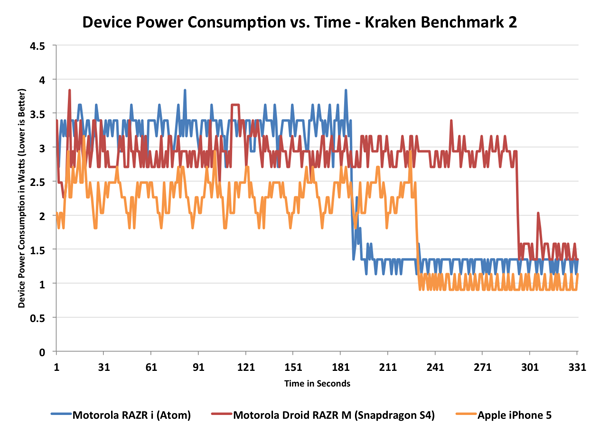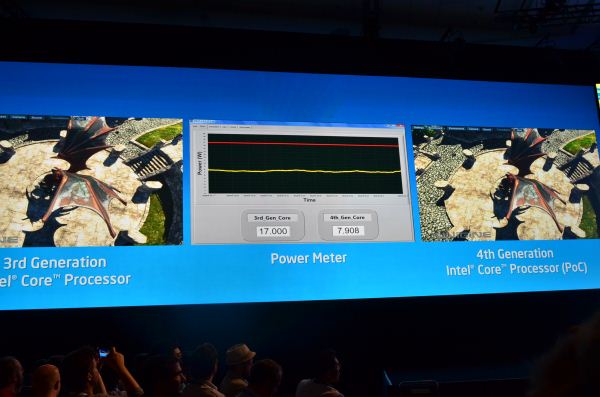The ARM vs x86 Wars Have Begun: In-Depth Power Analysis of Atom, Krait & Cortex A15
by Anand Lal Shimpi on January 4, 2013 7:32 AM EST- Posted in
- Tablets
- Intel
- Samsung
- Arm
- Cortex A15
- Smartphones
- Mobile
- SoCs
Final Words
Whereas I didn't really have anything new to conclude in the original article (Atom Z2760 is faster and more power efficient than Tegra 3), there's a lot to talk about here. We already know that Atom is faster than Krait, but from a power standpoint the two SoCs are extremely competitive. At the platform level Intel (at least in the Acer W510) generally leads in power efficiency. Note that this advantage could just as easily be due to display and other power advantages in the W510 itself and not necessarily indicative of an SoC advantage.
Looking at the CPU cores themselves, Qualcomm takes the lead. It's unclear how things would change if we could include L2 cache power consumption for Qualcomm as we do for Intel (see page 2 for an explanation). I suspect that Qualcomm does maintain the power advantage here though, even with the L2 cache included.
On the GPU side, Intel/Imagination win there although the roles reverse as Adreno 225 holds a performance advantage. For modern UI performance, the PowerVR SGX 545 is good enough but Adreno 225 is clearly the faster 3D GPU. Intel has underspecced its ultra mobile GPUs for a while, so a lot of the power advantage is due to the lower performing GPU. In 2D/modern UI tests however, the performance advantage isn't realized and thus the power advantage is still valid.
Qualcomm is able to generally push to lower idle power levels, indicating that even Intel's 32nm SoC process is getting a little long in the tooth. TSMC's 28nm LP and Samsung's 32nm LP processes both help silicon built in those fabs drive down to insanely low idle power levels. That being said, it is still surprising to me that a 5-year-old Atom architecture paired with a low power version of a 3-year-old process technology can be this competitive. In the next 9 - 12 months we'll finally get an updated, out-of-order Atom core built on a brand new 22nm low power/SoC process from Intel. This is one area where we should see real improvement. Intel's chances to do well in this space are good if it can manage to execute well and get its parts into designs people care about.

Device level power consumption, from our iPhone 5 review, look familiar?
If the previous article was about busting the x86 power myth, one key takeaway here is that Intel's low power SoC designs are headed in the right direction. Atom's power curve looks a lot like Qualcomm's, and I suspect a lot like Apple's. There are performance/power tradeoffs that all three make, but they're all being designed the way they should.
The Cortex A15 data is honestly the most intriguing. I'm not sure how the first A15 based smartphone SoCs will compare to Exynos 5 Dual in terms of power consumption, but at least based on the data here it looks like Cortex A15 is really in a league of its own when it comes to power consumption. Depending on the task that may not be an issue, but you still need a chassis that's capable of dissipating 1 - 4x the power of a present day smartphone SoC made by Qualcomm or Intel. Obviously for tablets the Cortex A15 can work just fine, but I am curious to see what will happen in a smartphone form factor. With lower voltage/clocks and a well architected turbo mode it may be possible to deliver reasonable battery life, but simply tossing the Exynos 5 Dual from the Nexus 10 into a smartphone isn't going to work well. It's very obvious to me why ARM proposed big.LITTLE with Cortex A15 and why Apple designed Swift.
I'd always heard about Haswell as the solution to the ARM problem, particularly in reference to the Cortex A15. The data here, particularly on the previous page, helped me understand exactly what that meant. Under a CPU or GPU heavy workload, the Exynos 5 Dual will draw around 4W. Peak TDP however is closer to 8W. If you remember back to IDF, Intel specifically called out 8W as a potential design target for Haswell. In reality, I expect that we'll see Haswell parts even lower power than that. While it may still be a stretch to bring Haswell down to 4W, it's very clear to me that Intel sees this as a possiblity in the near term. Perhaps not at 22nm, but definitely at 14nm. We already know Core can hit below 8W at 22nm, if it can get down to around 4W then that opens up a whole new class of form factors to a traditionally high-end architecture.
Ultimately I feel like that's how all of this is going to play out. Intel's Core architectures will likely service the 4W and above space, while Atom will take care of everything else below it. The really crazy part is that it's not too absurd to think about being able to get a Core based SoC into a large smartphone as early as 14nm, and definitely by 10nm (~2017) should the need arise. We've often talked about smartphones being used as mainstream computing devices in the future, but this is how we're going to get there. By the time Intel moves to 10nm ultramobile SoCs, you'll be able to get somewhere around Sandy/Ivy Bridge class performance in a phone.
At the end of the day, I'd say that Intel's chances for long term success in the tablet space are pretty good - at least architecturally. Intel still needs a Nexus, iPad or other similarly important design win, but it should have the right technology to get there by 2014. It's up to Paul or his replacement to ensure that everything works on the business side.
As far as smartphones go, the problem is a lot more complicated. Intel needs a good high-end baseband strategy which, as of late, the Infineon acquisition hasn't been able to produce. I've heard promising things in this regard but the baseband side of Intel remains embarassingly quiet. This is an area where Qualcomm is really the undisputed leader, Intel has a lot of work ahead of it here. As for the rest of the smartphone SoC, Intel is on the right track. Its existing architecture remains performance and power competitive with the best Qualcomm has to offer today. Both Intel and Qualcomm have architecture updates planned in the not too distant future (with Qualcomm out of the gate first), so this will be one interesting battle to watch. If ARM is the new AMD, then Krait is the new Athlon 64. The difference is, this time, Intel isn't shipping a Pentium 4.











140 Comments
View All Comments
kyuu - Friday, January 4, 2013 - link
You're the one stepping into the past with the CISC vs. RISC. x86 is not going to go away anytime soon. Keep dreaming, though.iwod - Saturday, January 5, 2013 - link
Nothing about Architectures in this comment, but by the time ARM Cortex A57 is out, so is Intel ValleyView, which doubles the performance. A57 is expected to give in best case scenario 30 - 50% increase in performance. And All of a sudden this look so similar to 2x Atom performance.It will only take one, just ONE mistake that ARM make for Intel to possibly wipe them off the map.
Although looking into the next 3 - 5 years ahead. It will be a bloody battle instead.
Cold Fussion - Friday, January 4, 2013 - link
Why didn't have any charts which were performance per watt or energy consumption vs performance in the GPU area? If the Mali chip is using twice the energy but giving 3x the performance then that is a very significant point thats being misrepresented.mrdude - Friday, January 4, 2013 - link
I was thinking the same thing.If I can game at native resolution on a Nexus 10 at better frame rates than on the Atom or Snapdragon SoC and the battery capacity is larger and the price of the device is equal, then do I really care about the battery life?
Although it's nice seeing Intel is getting x86 down to a competitive level with ARM, the most astonishing thing that I took away from that review was just how amazing that MaliT604 GPU is. All that performance and only that power draw? Yesplz :P
parkpy - Friday, January 4, 2013 - link
i've learned so much from AT's review of the iPhone5, Galaxy S III, and Nexus 4, and this article about mobile phones that it makes me wish AT could produce MORE reviews of mobile devices.All of this information is crack! I can't get enough of it. Keep up the good work! And Intel, I can't wait for you to get your baseband processor situation sorted out!
I was already tempted to get a Razr I, but it looks like before the end of the year consumers will have some very awesome technology in their phones that won't require as much time on the battery charger!
This Guy - Friday, January 4, 2013 - link
What if Rosepoint is software defined instead of fixed function?ddriver - Friday, January 4, 2013 - link
I am confused here - this review shows the atom to be somewhat faster than A15, while the review at phoronix shows the A15 destroying the atom, despite the fact intel's compiler is incredibly good at optimizations and incomparably more mature.So I am in a dilemma on who to trust - a website that is known to be generously sponsored by intel or a website that is heavily focused on open source.
What do you think?
kyuu - Friday, January 4, 2013 - link
Uh, did we read the same article? Where does it show the Atom being "somewhat faster than A15"? The article showed that the A15 is faster than Atom, but at a large power premium.ddriver - Friday, January 4, 2013 - link
On the charts I see the blue line ending its task first and taking less time, blue is atom, right?jwcalla - Friday, January 4, 2013 - link
A couple things:1) The Phoronix benchmarks were for different Atoms than the one used in this article. I don't know how they compare, but they're probably older models.
2) The Phoronix benchmarks used GCC 4.6 across the board. Yes, in general GCC will have better optimizations for x86, but we don't know anything (unless I missed it) about which compilers were used here. If this was an Intel sample sent to Anand, I'm sure they compiled the software stack with one of their own proprietary Intel compilers. Or perhaps it is the MS compiler, which no doubt has decades of x86 optimizations built in and probably less ARM work than GCC (for the RT comparison).
Don't take the benchmarks too seriously, especially since even the software isn't held constant here like it was in the Phoronix benchmarks. It's all ballpark information. Atom is competitive with ARMv7 architectures -- that's the takeaway.